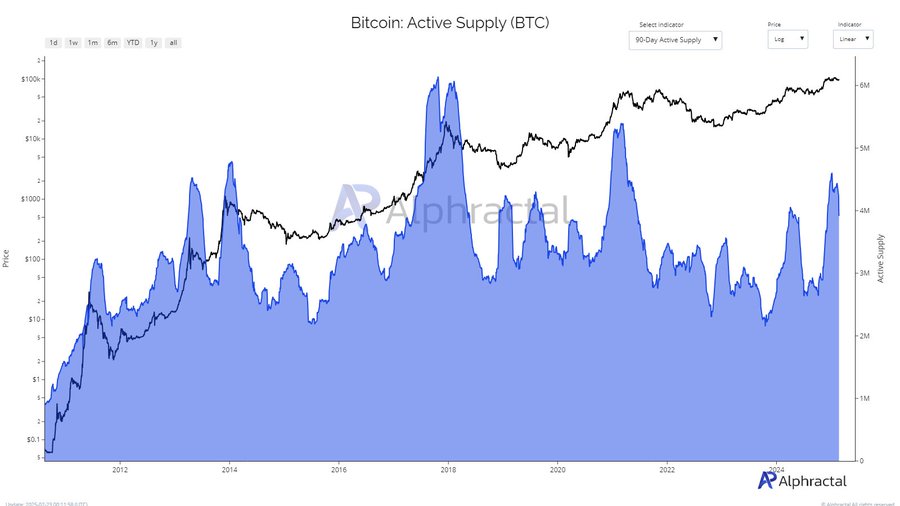- BTC STHs could have panic-sold in response to the current information in regards to the Bybit hack.
- Evaluation of the 90-Day Energetic Provide mirrored a notable decline in current months.
Prior to now 24 hours, Bitcoin [BTC] skilled notable volatility. Brief-Time period Holders (STHs) realized substantial losses, probably pushed by panic-selling following the Bybit hack information.
Additionally, over the previous 16 hours, BTC’s 4-hour chart on Binance confirmed vital bearish indicators.
The Exponential Transferring Common (EMA) cross displayed a bearish crossover, with the 9-period EMA dropping beneath the 26-period EMA round hour 14, signaling short-term downward momentum.
This aligned with BTC’s worth decline to $96,259.9, marking a -0.12% drop from the earlier interval.
The Relative Power Index (RSI) stood at 46.05, reflecting a impartial however barely bearish outlook.
This RSI degree recommended that BTC remained in a consolidation part, with no clear overbought or oversold circumstances. If it rebounds above 50, bullish sentiment would possibly return, supporting worth restoration.
Additionally, the Cumulative Quantity Delta (CVD) confirmed a internet quantity delta of -94.67K, reflecting sturdy promoting strain within the final 8 hours.
These alerts collectively pointed to capitulation, the place STHs offloaded BTC, probably forming a short-term native backside as promoting strain diminished.
Panic promoting peaks: What’s the turning level?
The Brief-Time period Holder Revenue & Loss (P&L) to Exchanges Sum chart for the final 24 hours additionally highlighted vital losses amongst STHs.
The dominance of crimson bars, peaking at -43.9K BTC, indicated heavy panic-selling round $90K to $95K following the Bybit hack information.
The STH revenue line remained minimal, reinforcing the concept that few short-term merchants noticed good points. Comparable developments occurred in early 2022, the place excessive realized losses preceded short-term worth recoveries.
This information recommended a possible native backside, as distressed promoting typically exhausts downward momentum, making a attainable shopping for window for merchants.
BTC’s liquidity shift
Evaluation of the 90-Day Energetic Provide chart for BTC, masking 2012 to 2025, mirrored a notable decline in current months. As of early 2025, energetic provide hovered round 4M BTC, down from 6M BTC in late 2024.
This metric, indicated a decline in buying and selling exercise. Usually, rising energetic provide suggests larger demand and bullish sentiment, whereas declines sign distribution and diminished curiosity.
The present pattern implied STHs had largely exited, probably decreasing promoting strain.
This sample mirrored 2018, when declining energetic provide preceded worth stabilization, supporting the capitulation speculation and reinforcing short-term backside formation.
An indication of power or additional decline?
Deep evaluation confirmed that BTC netflow chart for aggregated exchanges over the past three months revealed a pointy internet outflow of -546.11 BTC prior to now 24 hours.
This was a major reversal from the earlier week’s +226.57 BTC common inflows, and the 30-day common of +1.29K BTC inflows.
A sudden unfavorable netflow sometimes signifies that holders are withdrawing BTC to off-exchange wallets, suggesting diminished promoting strain.
This sample resembled mid-2021, when giant BTC outflows preceded worth rebounds. Moreover, the 24-hour netflow change of +269.71 BTC recommended renewed shopping for curiosity.
In conclusion, Capitulation occasions, similar to heavy short-term holder losses and declining trade netflows, traditionally precede short-term recoveries.
Whereas short-term volatility stays, long-term indicators counsel a possible shift towards restoration as promoting strain subsides.













